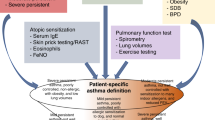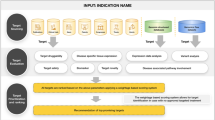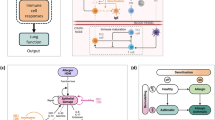Abstract
Asthma has a high prevalence worldwide, and contributes significantly to the socioeconomic burden. According to a classical paradigm, asthma symptoms are attributable to an allergic, Th2-driven airway inflammation that causes airway hyperresponsiveness and results in reversible airway obstruction. Diagnosis and therapy are based mainly on these pathophysiologic concepts. However, these have increasingly been challenged by findings of recent studies, and the frequently observed failure in controlling asthma symptoms. Important recent findings are the protective “farm effect” in children, the possible prenatal mechanisms of this protection, the recognition of many different asthma phenotypes in children and adults, and the partly disappointing clinical effects of new targeted therapeutic approaches. Systems biology approaches may lead to a more comprehensive view of asthma pathophysiology and a higher success rate of new therapies. Systems biology integrates clinical and experimental data by means of bioinformatics and mathematical modeling. In general, the “-omics” approach, and the “mathematical modeling” approach can be described. Recently, several consortia have been attempting to bring together clinical and molecular data from large asthma cohorts, using novel experimental setups, biostatistics, bioinformatics, and mathematical modeling. This “systems medicine” approach to asthma will help address the different asthma phenotypes with adequate therapy and possibly preventive strategies.
Similar content being viewed by others
Log in or create a free account to read this content
Gain free access to this article, as well as selected content from this journal and more on nature.com
or
References
Busse WW, Lemanske RF Jr . Asthma. N Engl J Med 2001;344:350–62.
Eder W, Ege MJ, von Mutius E . The asthma epidemic. N Engl J Med 2006;355:2226–35.
Haldar P, Pavord ID, Shaw DE, et al. Cluster analysis and clinical asthma phenotypes. Am J Respir Crit Care Med 2008;178:218–24.
Barnes PJ . Immunology of asthma and chronic obstructive pulmonary disease. Nat Rev Immunol 2008;8:183–92.
Gonem S, Desai D, Siddiqui S, Brightling CC . Evidence for phenotype-driven treatment in asthmatic patients. Curr Opin Allergy Clin Immunol 2011;11:381–5.
McGrath KW, Icitovic N, Boushey HA, et al.; Asthma Clinical Research Network of the National Heart, Lung, and Blood Institute. A large subgroup of mild-to-moderate asthma is persistently noneosinophilic. Am J Respir Crit Care Med 2012;185:612–9.
Auffray C, Adcock IM, Chung KF, Djukanovic R, Pison C, Sterk PJ . An integrative systems biology approach to understanding pulmonary diseases. Chest 2010;137:1410–6.
Strachan DP . Hay fever, hygiene, and household size. BMJ 1989;299:1259–60.
Aberg N . Asthma and allergic rhinitis in Swedish conscripts. Clin Exp Allergy 1989;19:59–63.
Von Ehrenstein OS, Von Mutius E, Illi S, Baumann L, Böhm O, von Kries R . Reduced risk of hay fever and asthma among children of farmers. Clin Exp Allergy 2000;30:187–93.
Riedler J, Braun-Fahrländer C, Eder W, et al.; ALEX Study Team. Exposure to farming in early life and development of asthma and allergy: a cross-sectional survey. Lancet 2001;358:1129–33.
von Mutius E, Vercelli D . Farm living: effects on childhood asthma and allergy. Nat Rev Immunol 2010;10:861–8.
Brooks C, Pearce N, Douwes J . The hygiene hypothesis in allergy and asthma: an update. Curr Opin Allergy Clin Immunol 2013;13:70–7.
Chen Y, Blaser MJ . Helicobacter pylori colonization is inversely associated with childhood asthma. J Infect Dis 2008;198:553–60.
Braun-Fahrländer C, Riedler J, Herz U, et al.; Allergy and Endotoxin Study Team. Environmental exposure to endotoxin and its relation to asthma in school-age children. N Engl J Med 2002;347:869–77.
van Strien RT, Engel R, Holst O, et al.; ALEX Study Team. Microbial exposure of rural school children, as assessed by levels of N-acetyl-muramic acid in mattress dust, and its association with respiratory health. J Allergy Clin Immunol 2004;113:860–7.
Ege MJ, Mayer M, Normand AC, et al.; GABRIELA Transregio 22 Study Group. Exposure to environmental microorganisms and childhood asthma. N Engl J Med 2011;364:701–9.
Genuneit J . Exposure to farming environments in childhood and asthma and wheeze in rural populations: a systematic review with meta-analysis. Pediatr Allergy Immunol 2012;23:509–18.
Macy E, Schatz M, Gibbons C, Zeiger R . The prevalence of reversible airflow obstruction and/or methacholine hyperreactivity in random adult asthma patients identified by administrative data. J Asthma 2005;42:213–20.
Fuchs O, Genuneit J, Latzin P, et al.; GABRIELA Study Group. Farming environments and childhood atopy, wheeze, lung function, and exhaled nitric oxide. J Allergy Clin Immunol 2012;130:382–8.e6.
Omland Ø, Hjort C, Pedersen OF, Miller MR, Sigsgaard T . New-onset asthma and the effect of environment and occupation among farming and nonfarming rural subjects. J Allergy Clin Immunol 2011;128:761–5.
von Hertzen L, Hanski I, Haahtela T . Natural immunity. Biodiversity loss and inflammatory diseases are two global megatrends that might be related. EMBO Rep 2011;12:1089–93.
Hanski I, von Hertzen L, Fyhrquist N, et al. Environmental biodiversity, human microbiota, and allergy are interrelated. Proc Natl Acad Sci USA 2012;109:8334–9.
von Mutius E . A fascinating look at the world with a new microscope. J Allergy Clin Immunol 2012;129:1202–3.
Lim RH, Kobzik L . Maternal transmission of asthma risk. Am J Reprod Immunol 2009;61:1–10.
McKeever TM, Lewis SA, Smith C, Hubbard R . The importance of prenatal exposures on the development of allergic disease: a birth cohort study using the West Midlands General Practice Database. Am J Respir Crit Care Med 2002;166:827–32.
Ege MJ, Bieli C, Frei R, et al.; Parsifal Study team. Prenatal farm exposure is related to the expression of receptors of the innate immunity and to atopic sensitization in school-age children. J Allergy Clin Immunol 2006;117:817–23.
Douwes J, Cheng S, Travier N, et al. Farm exposure in utero may protect against asthma, hay fever and eczema. Eur Respir J 2008;32:603–11.
Mold JE, Michaëlsson J, Burt TD, et al. Maternal alloantigens promote the development of tolerogenic fetal regulatory T cells in utero. Science 2008;322:1562–5.
Schaub B, Liu J, Höppler S, et al. Maternal farm exposure modulates neonatal immune mechanisms through regulatory T cells. J Allergy Clin Immunol 2009;123:774–82.e5.
Pfefferle PI, Büchele G, Blümer N, et al.; PASTURE Study Group. Cord blood cytokines are modulated by maternal farming activities and consumption of farm dairy products during pregnancy: the PASTURE Study. J Allergy Clin Immunol 2010;125:108–15.e1–3.
Macaubas C, de Klerk NH, Holt BJ, et al. Association between antenatal cytokine production and the development of atopy and asthma at age 6 years. Lancet 2003;362:1192–7.
Blümer N, Herz U, Wegmann M, Renz H . Prenatal lipopolysaccharide-exposure prevents allergic sensitization and airway inflammation, but not airway responsiveness in a murine model of experimental asthma. Clin Exp Allergy 2005;35:397–402.
Conrad ML, Ferstl R, Teich R, et al. Maternal TLR signaling is required for prenatal asthma protection by the nonpathogenic microbe Acinetobacter lwoffii F78. J Exp Med 2009;206:2869–77.
Brand S, Teich R, Dicke T, et al. Epigenetic regulation in murine offspring as a novel mechanism for transmaternal asthma protection induced by microbes. J Allergy Clin Immunol 2011;128:618–25.e1–7.
McCallister JW . Reslizumab and eosinophilic asthma: one step closer to phenotype-directed therapy? Am J Respir Crit Care Med 2011;184:1096–7.
Martinez FD, Chinchilli VM, Morgan WJ, et al. Use of beclomethasone dipropionate as rescue treatment for children with mild persistent asthma (TREXA): a randomised, double-blind, placebo-controlled trial. Lancet 2011;377:650–7.
Zeiger RS, Mauger D, Bacharier LB, et al.; CARE Network of the National Heart, Lung, and Blood Institute. Daily or intermittent budesonide in preschool children with recurrent wheezing. N Engl J Med 2011;365:1990–2001.
Moore WC, Meyers DA, Wenzel SE, et al.; National Heart, Lung, and Blood Institute’s Severe Asthma Research Program. Identification of asthma phenotypes using cluster analysis in the Severe Asthma Research Program. Am J Respir Crit Care Med 2010;181:315–23.
Siroux V, Basagaña X, Boudier A, et al. Identifying adult asthma phenotypes using a clustering approach. Eur Respir J 2011;38:310–7.
Wenzel SE, Vitari CA, Shende M, Strollo DC, Larkin A, Yousem SA . Asthmatic granulomatosis: a novel disease with asthmatic and granulomatous features. Am J Respir Crit Care Med 2012;186:501–7.
Fleming L, Tsartsali L, Wilson N, Regamey N, Bush A . Sputum inflammatory phenotypes are not stable in children with asthma. Thorax 2012;67:675–81.
Wenzel SE . Asthma phenotypes: the evolution from clinical to molecular approaches. Nat Med 2012;18:716–25.
Tantisira KG, Lasky-Su J, Harada M, et al. Genomewide association between GLCCI1 and response to glucocorticoid therapy in asthma. N Engl J Med 2011;365:1173–83.
Wechsler ME, Castro M, Lehman E, et al.; NHLBI Asthma Clinical Research Network. Impact of race on asthma treatment failures in the asthma clinical research network. Am J Respir Crit Care Med 2011;184:1247–53.
Weatherall M, Wijesinghe M, Perrin K, Harwood M, Beasley R . Meta-analysis of the risk of mortality with salmeterol and the effect of concomitant inhaled corticosteroid therapy. Thorax 2010;65:39–43.
Bleecker ER, Nelson HS, Kraft M, et al. Beta2-receptor polymorphisms in patients receiving salmeterol with or without fluticasone propionate. Am J Respir Crit Care Med 2010;181:676–87.
Iwamoto H, Yokoyama A, Shiota N, et al. Tiotropium bromide is effective for severe asthma with noneosinophilic phenotype. Eur Respir J 2008;31:1379–80.
Simpson JL, Powell H, Boyle MJ, Scott RJ, Gibson PG . Clarithromycin targets neutrophilic airway inflammation in refractory asthma. Am J Respir Crit Care Med 2008;177:148–55.
A plea to abandon asthma as a disease concept. Lancet 2006;368:705.
Anderson GP . Endotyping asthma: new insights into key pathogenic mechanisms in a complex, heterogeneous disease. Lancet 2008;372:1107–19.
Busse WW, Morgan WJ, Gergen PJ, et al. Randomized trial of omalizumab (anti-IgE) for asthma in inner-city children. N Engl J Med 2011;364:1005–15.
Leckie MJ, ten Brinke A, Khan J, et al. Effects of an interleukin-5 blocking monoclonal antibody on eosinophils, airway hyper-responsiveness, and the late asthmatic response. Lancet 2000;356:2144–8.
Haldar P, Brightling CE, Hargadon B, et al. Mepolizumab and exacerbations of refractory eosinophilic asthma. N Engl J Med 2009;360:973–84.
Nair P, Pizzichini MM, Kjarsgaard M, et al. Mepolizumab for prednisone-dependent asthma with sputum eosinophilia. N Engl J Med 2009;360:985–93.
Castro M, Mathur S, Hargreave F, et al.; Res-5-0010 Study Group. Reslizumab for poorly controlled, eosinophilic asthma: a randomized, placebo-controlled study. Am J Respir Crit Care Med 2011;184:1125–32.
Borish LC, Nelson HS, Lanz MJ, et al. Interleukin-4 receptor in moderate atopic asthma. A phase I/II randomized, placebo-controlled trial. Am J Respir Crit Care Med 1999;160:1816–23.
Maes T, Joos GF, Brusselle GG . Targeting interleukin-4 in asthma: lost in translation? Am J Respir Cell Mol Biol 2012;47:261–70.
Corren J, Lemanske RF, Hanania NA, et al. Lebrikizumab treatment in adults with asthma. N Engl J Med 2011;365:1088–98.
Berry MA, Hargadon B, Shelley M, et al. Evidence of a role of tumor necrosis factor alpha in refractory asthma. N Engl J Med 2006;354:697–708.
Holgate ST, Noonan M, Chanez P, et al. Efficacy and safety of etanercept in moderate-to-severe asthma: a randomised, controlled trial. Eur Respir J 2011;37:1352–9.
Mestas J, Hughes CC . Of mice and not men: differences between mouse and human immunology. J Immunol 2004;172:2731–8.
Wenzel S, Holgate ST . The mouse trap: It still yields few answers in asthma. Am J Respir Crit Care Med 2006;174:1173–6; discussion 1176–8.
Quackenbush J . Computational approaches to analysis of DNA microarray data. Yearb Med Inform 2006;91–103.
van ‘t Veer LJ, Dai H, van de Vijver MJ, et al. Gene expression profiling predicts clinical outcome of breast cancer. Nature 2002;415:530–6.
Zou J, Young S, Zhu F, et al. Microarray profile of differentially expressed genes in a monkey model of allergic asthma. Genome Biol 2002;3:research0020.
Park SG, Choi JW, Kim Hj, et al. Genome-wide profiling of antigen-induced time course expression using murine models for acute and chronic asthma. Int Arch Allergy Immunol 2008;146:44–56.
Gray RD, MacGregor G, Noble D, et al. Sputum proteomics in inflammatory and suppurative respiratory diseases. Am J Respir Crit Care Med 2008;178:444–52.
Zhao J, Zhu H, Wong CH, Leung KY, Wong WS . Increased lungkine and chitinase levels in allergic airway inflammation: a proteomics approach. Proteomics 2005;5:2799–807.
Ghosh S, Janocha AJ, Aronica MA, et al. Nitrotyrosine proteome survey in asthma identifies oxidative mechanism of catalase inactivation. J Immunol 2006;176:5587–97.
Jardim MJ, Dailey L, Silbajoris R, Diaz-Sanchez D . Distinct microRNA expression in human airway cells of asthmatic donors identifies a novel asthma-associated gene. Am J Respir Cell Mol Biol 2012;47:536–42.
O’Neil SE, Sitkauskiene B, Babusyte A, et al. Network analysis of quantitative proteomics on asthmatic bronchi: effects of inhaled glucocorticoid treatment. Respir Res 2011;12:124.
Vera J, Wolkenhauer O . A system biology approach to understand functional activity of cell communication systems. Methods Cell Biol 2008;90:399–415.
Ashall L, Horton CA, Nelson DE, et al. Pulsatile stimulation determines timing and specificity of NF-kappaB-dependent transcription. Science 2009;324:242–6.
Busse D, de la Rosa M, Hobiger K, et al. Competing feedback loops shape IL-2 signaling between helper and regulatory T lymphocytes in cellular microenvironments. Proc Natl Acad Sci USA 2010;107:3058–63.
Hoffmann A, Levchenko A, Scott ML, Baltimore D . The IkappaB-NF-kappaB signaling module: temporal control and selective gene activation. Science 2002;298:1241–5.
Nelson DE, Ihekwaba AE, Elliott M, et al. Oscillations in NF-kappaB signaling control the dynamics of gene expression. Science 2004;306:704–8.
Nikolov S, Vera J, Rath O, Kolch W, Wolkenhauer O . Role of inhibitory proteins as modulators of oscillations in NFB signalling. IET Syst Biol 2009;3:59–76.
Hwang S, Son SW, Kim SC, Kim YJ, Jeong H, Lee D . A protein interaction network associated with asthma. J Theor Biol 2008;252:722–31.
Höfer T, Nathansen H, Löhning M, Radbruch A, Heinrich R . GATA-3 transcriptional imprinting in Th2 lymphocytes: a mathematical model. Proc Natl Acad Sci USA 2002;99:9364–8.
van den Ham HJ, de Boer RJ . From the two-dimensional Th1 and Th2 phenotypes to high-dimensional models for gene regulation. Int Immunol 2008;20:1269–77.
Podtschaske M, Benary U, Zwinger S, Höfer T, Radbruch A, Baumgrass R . Digital NFATc2 activation per cell transforms graded T cell receptor activation into an all-or-none IL-2 expression. PLoS ONE 2007;2:e935.
Frey U, Brodbeck T, Majumdar A, et al. Risk of severe asthma episodes predicted from fluctuation analysis of airway function. Nature 2005;438:667–70.
Thamrin C, Stern G, Strippoli MP, et al. Fluctuation analysis of lung function as a predictor of long-term response to beta2-agonists. Eur Respir J 2009;33:486–93.
Frey U . Asthma as a nonlinear complex dynamic system: a novel approach to understand the temporal behaviour of chronic asthma and its response to β-agonists. Eur Respir Rev 2008;17:67–9.
Hunter P, Smith N, Fernandez J, Tawhai M . Integration from proteins to organs: the IUPS Physiome Project. Mech Ageing Dev 2005;126:187–92.
Lauzon AM, Bates JH, Donovan G, Tawhai M, Sneyd J, Sanderson MJ . A multi-scale approach to airway hyperresponsiveness: from molecule to organ. Front Physiol 2012;3:191.
Patel B, Gauvin R, Absar S, et al. Computational and bioengineered lungs as alternatives to whole animal, isolated organ, and cell-based lung models. Am J Physiol Lung Cell Mol Physiol 2012;303:L733–47.
Martonen T, Fleming J, Schroeter J, Conway J, Hwang D . In silico modeling of asthma. Adv Drug Deliv Rev 2003;55:829–49.
Seeger W, Welte T, Eickelberg O, et al. The German centre for lung research — translational research for the prevention, diagnosis and treatment of respiratory diseases. Pneumologie 2012;66:464–9.
Bel EH, Sousa A, Fleming L, et al.; Unbiased Biomarkers for the Prediction of Respiratory Disease Outcome (U-BIOPRED) Consortium, Consensus Generation. Diagnosis and definition of severe refractory asthma: an international consensus statement from the Innovative Medicine Initiative (IMI). Thorax 2011;66:910–7.
Maier D, Kalus W, Wolff M, et al. Knowledge management for systems biology a general and visually driven framework applied to translational medicine. BMC Syst Biol 2011;5:38.
Politi AZ, Donovan GM, Tawhai MH, et al. A multiscale, spatially distributed model of asthmatic airway hyper-responsiveness. J Theor Biol 2010;266:614–24.
Acknowledgements
We acknowledge excellent support from Marlene Sülberg in manuscript preparation and proofreading. We apologize to all colleagues whose excellent contributions to the field could not be included in this text due to space constraints.
Author information
Authors and Affiliations
Corresponding author
Rights and permissions
About this article
Cite this article
Sittka, A., Vera, J., Lai, X. et al. Asthma phenotyping, therapy, and prevention: what can we learn from systems biology?. Pediatr Res 73, 543–552 (2013). https://doi.org/10.1038/pr.2013.8
Received:
Accepted:
Published:
Issue date:
DOI: https://doi.org/10.1038/pr.2013.8
This article is cited by
-
The Potential for Emerging Microbiome-Mediated Therapeutics in Asthma
Current Allergy and Asthma Reports (2017)
-
Asthma Pharmacogenomics: 2015 Update
Current Allergy and Asthma Reports (2015)
-
Systems biology and pediatric research
Pediatric Research (2013)



